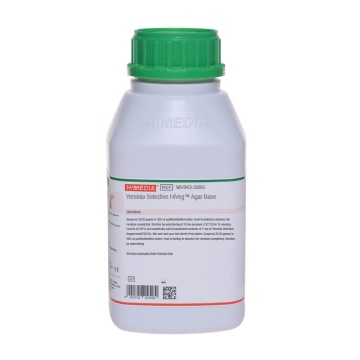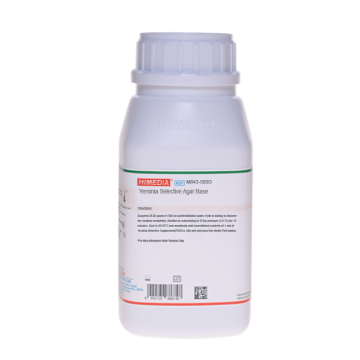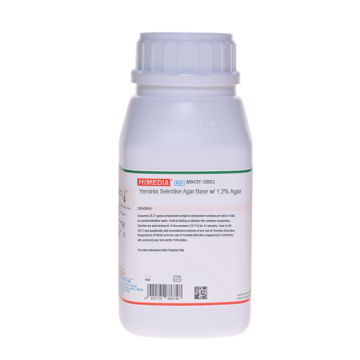 Your enquiry has been submitted
Your enquiry has been submitted
MOX Agar
Intended Use
Recommended for the cultivation of Yersinia enterocolitica from food.
Composition
| Ingredients | Gms / Litre |
|---|---|
| Tryptone | 15.000 |
| Soya peptone | 5.000 |
| Sodium chloride | 5.000 |
| Magnesium chloride hexahydrate | 4.067 |
| Sodium oxalate | 2.680 |
| Agar | 15.000 |
Final pH (at 25°C): 7.5±0.1
**Formula adjusted, standardized to suit performance parameters
Directions
Suspend 44.58 (the equivalent weight of dehydrated medium per litre) grams in 1000 ml purified / distilled water. Heat to boiling with stirring to dissolve the medium completely. Sterilize by autoclaving at 15 lbs pressure (121°C) for 15 minutes. Cool to 45-50°C. Mix well and pour into sterile Petri plates.
Principle And Interpretation
Yersinia enterocolitica, a gram-negative coccobacillus shaped bacterium, is often isolated from clinical specimens such as wounds, faeces, sputum and mesenteric lymph nodes. It is a foodborne pathogen responsible for gastroenteritis. However, it is not a part of the normal human flora. Strains of Y. enterocolitica can be found in meats (pork, beef, lamb, etc.), oysters, fish, and raw milk. MOX Agar is formulated as per APHA (6) for the cultivation of Y. enterocolitica, a causative agent of human illness caused due to consumption of contaminated food (2).
Tryptone and soya peptone in the medium provide essential growth nutrients. Magnesium chloride and sodium oxalate enhance growth of Y. enterocolitica.
Aseptically collected food samples are sealed in containers to prevent dehydration, contamination in transit and to protect handlers. In case of delay, refrigeration is preferable to freezing since the latter may result in cell injury. Yersinia is sensitive to acid conditions, therefore acid foods and fermented products should be analyzed promptly. Yersinia is a psychrotroph hence cold enrichment at 4°C has been commonly used as the incubation temperature (6).
Type of specimen
Food and dairy samples
Specimen Collection and Handling:
Aseptically collected food samples are sealed in containers to prevent dehydration, contamination in transit and to protect handlers. In case of delay, refrigeration is preferable to freezing since the latter may result in cell injury. Yersinia is sensitive to acid conditions, therefore acid foods and fermented products should be analyzed promptly. Yersinia is a psychrotroph hence cold enrichment at 4°C has been commonly used as the incubation temperature (6).
Warning and Precautions :
Read the label before opening the container. Wear protective gloves/protective clothing/eye protection/ face protection. Follow good microbiological lab practices while handling specimens and culture. Standard precautions as per established guidelines should be followed while handling specimens. Safety guidelines may be referred in individual safety data sheets.
Limitations :
- Yersinia is a psychrotroph hence cold enrichment at 4°C has been commonly used as the incubation temperature (1).
Performance and Evaluation
Performance of the medium is expected when used as per the direction on the label within the expiry period when stored at recommended temperature.
Quality Control
Appearance Cream to yellow homogeneous free flowing powder
Gelling Firm, comparable with 1.5% Agar gel
Colour and Clarity of prepared medium Yellow coloured opalescent to slightly hazy gel forms in Petri plates
Reaction Reaction of 4.68% w/v aqueous solution at 25°C. pH: 7.5±0.1
pH 7.40-7.60
Cultural Response Cultural characteristics observed after an incubation at 25-30°C for 24-48 hours.
| Organism | Inoculum (CFU) | Growth | Recovery |
|---|---|---|---|
| Yersinia enterocolitica ATCC 27729 | 50-100 | good-luxuriant | >=50% |
Storage and Shelf Life
Store between 10-30°C in a tightly closed container and the prepared medium at 20-30°C. Use before expiry date on the label. On opening, product should be properly stored dry, after tightly capping the bottle in order to prevent lump formation due to the hygroscopic nature of the product. Improper storage of the product may lead to lump formation. Store in dry ventilated area protected from extremes of temperature and sources of ignition Seal the container tightly after use. Product performance is best if used within stated expiry period.
Disposal
User must ensure safe disposal by autoclaving and/or incineration of used or unusable preparations of this product. Follow established laboratory procedures in disposing of infectious materials and material that comes into contact with sample must be decontaminated and disposed of in accordance with current laboratory techniques (3,4).
Reference
- American Public Health Association, Standard Methods for the Examination of Dairy Products, 1978, 14th Ed.,Washington D.C.
- FDA Bacteriological Analytical Manual, 2005, 18th Ed., AOAC, Washington, D.C.
- Isenberg, H.D. Clinical Microbiology Procedures Handbook 2nd Edition.
- Jorgensen, J.H., Pfaller, M.A., Carroll, K.C., Funke, G., Landry, M.L., Richter, S.S and Warnock., D.W. (2015) Manual of Clinical Microbiology, 11th Edition. Vol. 1.
- Salfinger Y., and Tortorello M.L., 2015, Compendium of Methods for the Microbiological Examination of Foods, 5th Ed., American Public Health Association, Washington, D.C.
- Vanderzant C., Splittstoesser D. F., 1992, Compendium of Methods for the Microbiological Examination of Foods, 3rd Ed., APHA, Washington, D.C
- Wehr H. M. and Frank J. H., 2004, Standard Methods for the Microbiological Examination of Dairy Products, 17th Ed.,APHA Inc., Washington, D.C.
Revision : 03/2019
| Product Name | MOX Agar |
|---|---|
| SKU | M1167 |
| Product Type | Regular |
| Physical Form | Powder |
| Origin | Animal |
| Packaging type | HDPE |
| References | 1. American Public Health Association, Standard Methods for the Examination of Dairy Products, 1978, 14th Ed.,Washington D.C. |
| Customized Product Available | No |











